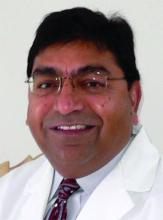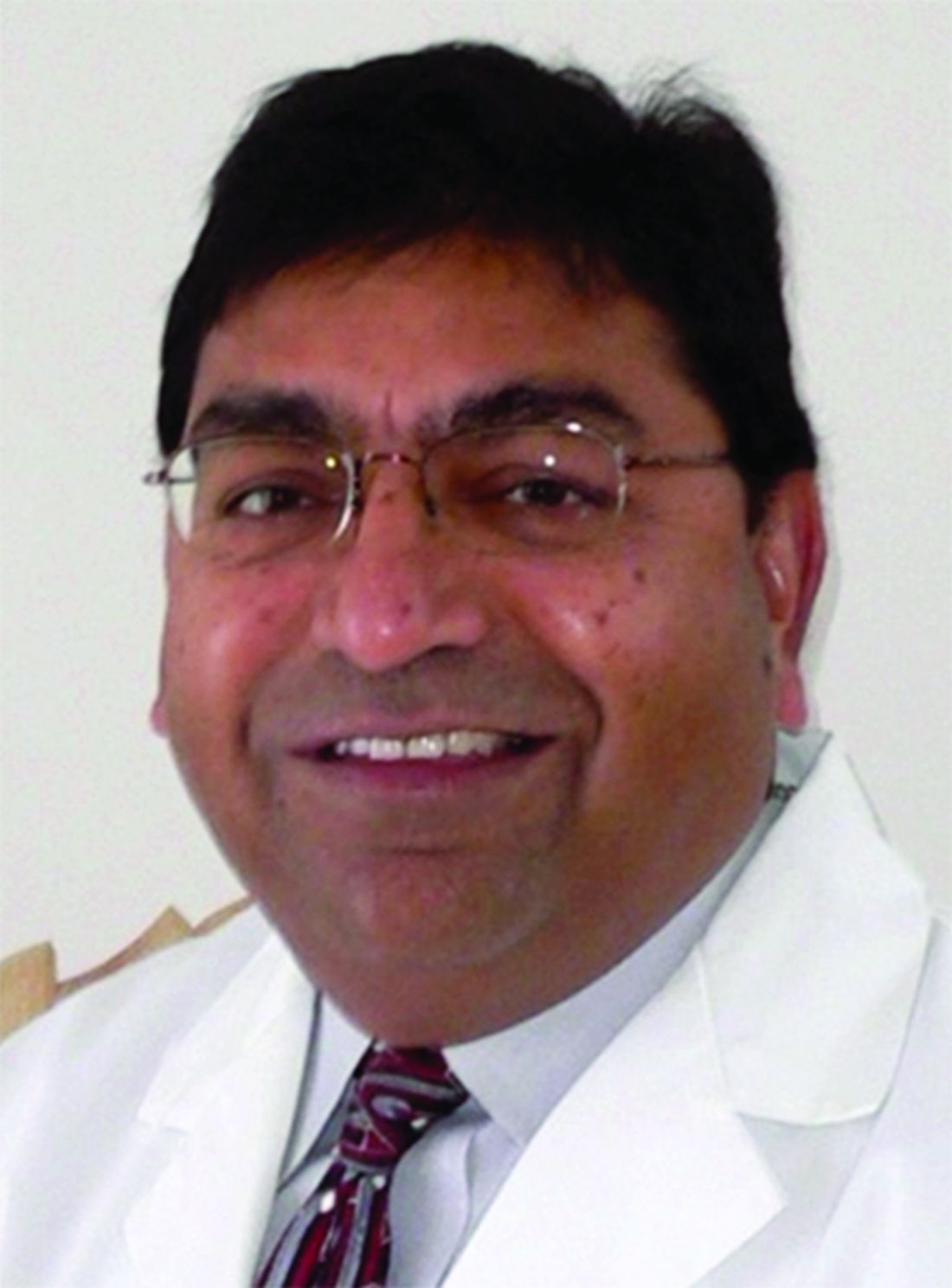User login
The current approach to esophageal function testing is insufficient to characterize esophageal motility disorders, as many patients with esophageal dysphagia have abnormalities that are undetectable with routine tests, according to investigators.
More nuanced assessments of esophageal motility disorders could potentially lead to more accurate diagnoses, and more effective treatments, reported Ravinder K. Mittal, MD, and Ali Zifan, PhD, of the University of California San Diego.
Esophageal motility disorders are currently divided into major and minor variants based on the contraction phase of peristalsis, Dr. Mittal and Dr. Zifan wrote in their report in Gastro Hep Advances. Yet the reason for dysphagia in many of these patients remains a puzzle, particularly in patients with supernormal contraction during peristalsis, like those with nutcracker esophagus. What’s more, up to half of patients with dysphagia have normal findings on high-resolution manometry impedance (HRMZ), the typical diagnostic modality, leaving many with the broad label of functional dysphagia.
This lack of clarity “suggests that the etiology in many patients remains unknown,” according to the investigators, which prompted them to publish the present review article.
After describing the shortcomings of current test methods, the investigators provided an overview of the physiology of esophageal peristalsis, then dove deeper into available data concerning luminal cross section measurements, esophageal distension during peristalsis, bolus flow, and distension contraction patterns in normal patients versus those with various kinds of dysphagia.
They highlighted two key findings.
First, in patients with functional dysphagia, esophagogastric junction outflow obstruction (EGJOO), and high amplitude esophageal peristaltic contractions (HAEC), the bolus must travel through a narrow esophageal lumen. Second, in patients with nonobstructive dysphagia and type 3 achalasia, the bolus moves against distal luminal occlusion.
“These findings indicate a relative dynamic obstruction to bolus flow and reduced distensibility of the esophageal wall in patients with several primary esophageal motility disorders,” the investigators wrote. “We speculate that the dysphagia sensation experienced by many patients may result from a normal or supernormal contraction wave pushing the bolus against resistance.”
Yet routine esophageal function testing fails to capture these abnormalities, Dr. Mittal and Dr. Zifan noted.
“[C]urrent techniques used to measure esophageal distension during peristalsis are not adequate,” they wrote. “The high-resolution manometry and current scheme of classifying esophageal motor disorders in the current format emphasize only half of the story of peristalsis, probably the less important of the two halves, i.e., the contraction phase of peristalsis.”
More focus is needed on esophageal distension, they suggested, noting that relaxation is first needed to accommodate a bolus before contraction, no matter how powerful, can push it down the esophagus.
“A simple analogy is that of a car — it cannot get through a roadway that is smaller than its own width, irrespective of the horsepower of its engine,” they wrote.
The solution may lie in a more comprehensive approach to esophageal function testing.
“Integrating representations of distension and contraction, along with objective assessments of flow timing and distensibility, complements the current classification of esophageal motility disorders that are based on the contraction characteristics,” the investigators wrote, predicting that these efforts could improve diagnostic accuracy.
What to do about those diagnoses is another mystery.
“The question though remains regarding the optimal treatment for the impaired distension function of the esophagus, and whether improvement in the distension function will lead to improvement in dysphagia symptoms,” the investigators concluded.
The review was supported by the National Institutes of Health. The investigators reported copyright/patent protection for the computer software (Dplots) used to evaluate the distension contraction plots.
Medicine is strewn with diseases first labeled as functional or psychologically induced that have been recategorized into clear non-sensory disorders of which functional dysphagia is one.
In this review article, Dr. Mittal and Dr. Zifan discuss a summary and new paradigm for esophageal motility disorders and the origin of functional dysphagia (FD). As with other functional disorders, the predominance of research has suggested that functional dysphagia is in large part a sensory disorder in which patient are sensing normally sub-threshold events of normal bolus transit interpreted as dysphagia.
Will this lead to recategorization of all functional dysphagia as a perturbation in motor function and the discovery of new therapies? Certainly, to some degree, though sensory dysfunction will likely remain a prominent mechanism in some patients. Nevertheless, it is always exciting when a new approach to an old disorder emerges. With the work from Dr. Mittal’s laboratory and many others, functional dysphagia may soon drop the functional!
David A. Katzka, MD, is a gastroenterologist at New York–Presbyterian/Columbia University Irving Medical Center, New York, where he leads the Esophagology and Swallowing Center. He has performed research for Medtronic, but has no other relevant disclosures.
Medicine is strewn with diseases first labeled as functional or psychologically induced that have been recategorized into clear non-sensory disorders of which functional dysphagia is one.
In this review article, Dr. Mittal and Dr. Zifan discuss a summary and new paradigm for esophageal motility disorders and the origin of functional dysphagia (FD). As with other functional disorders, the predominance of research has suggested that functional dysphagia is in large part a sensory disorder in which patient are sensing normally sub-threshold events of normal bolus transit interpreted as dysphagia.
Will this lead to recategorization of all functional dysphagia as a perturbation in motor function and the discovery of new therapies? Certainly, to some degree, though sensory dysfunction will likely remain a prominent mechanism in some patients. Nevertheless, it is always exciting when a new approach to an old disorder emerges. With the work from Dr. Mittal’s laboratory and many others, functional dysphagia may soon drop the functional!
David A. Katzka, MD, is a gastroenterologist at New York–Presbyterian/Columbia University Irving Medical Center, New York, where he leads the Esophagology and Swallowing Center. He has performed research for Medtronic, but has no other relevant disclosures.
Medicine is strewn with diseases first labeled as functional or psychologically induced that have been recategorized into clear non-sensory disorders of which functional dysphagia is one.
In this review article, Dr. Mittal and Dr. Zifan discuss a summary and new paradigm for esophageal motility disorders and the origin of functional dysphagia (FD). As with other functional disorders, the predominance of research has suggested that functional dysphagia is in large part a sensory disorder in which patient are sensing normally sub-threshold events of normal bolus transit interpreted as dysphagia.
Will this lead to recategorization of all functional dysphagia as a perturbation in motor function and the discovery of new therapies? Certainly, to some degree, though sensory dysfunction will likely remain a prominent mechanism in some patients. Nevertheless, it is always exciting when a new approach to an old disorder emerges. With the work from Dr. Mittal’s laboratory and many others, functional dysphagia may soon drop the functional!
David A. Katzka, MD, is a gastroenterologist at New York–Presbyterian/Columbia University Irving Medical Center, New York, where he leads the Esophagology and Swallowing Center. He has performed research for Medtronic, but has no other relevant disclosures.
The current approach to esophageal function testing is insufficient to characterize esophageal motility disorders, as many patients with esophageal dysphagia have abnormalities that are undetectable with routine tests, according to investigators.
More nuanced assessments of esophageal motility disorders could potentially lead to more accurate diagnoses, and more effective treatments, reported Ravinder K. Mittal, MD, and Ali Zifan, PhD, of the University of California San Diego.
Esophageal motility disorders are currently divided into major and minor variants based on the contraction phase of peristalsis, Dr. Mittal and Dr. Zifan wrote in their report in Gastro Hep Advances. Yet the reason for dysphagia in many of these patients remains a puzzle, particularly in patients with supernormal contraction during peristalsis, like those with nutcracker esophagus. What’s more, up to half of patients with dysphagia have normal findings on high-resolution manometry impedance (HRMZ), the typical diagnostic modality, leaving many with the broad label of functional dysphagia.
This lack of clarity “suggests that the etiology in many patients remains unknown,” according to the investigators, which prompted them to publish the present review article.
After describing the shortcomings of current test methods, the investigators provided an overview of the physiology of esophageal peristalsis, then dove deeper into available data concerning luminal cross section measurements, esophageal distension during peristalsis, bolus flow, and distension contraction patterns in normal patients versus those with various kinds of dysphagia.
They highlighted two key findings.
First, in patients with functional dysphagia, esophagogastric junction outflow obstruction (EGJOO), and high amplitude esophageal peristaltic contractions (HAEC), the bolus must travel through a narrow esophageal lumen. Second, in patients with nonobstructive dysphagia and type 3 achalasia, the bolus moves against distal luminal occlusion.
“These findings indicate a relative dynamic obstruction to bolus flow and reduced distensibility of the esophageal wall in patients with several primary esophageal motility disorders,” the investigators wrote. “We speculate that the dysphagia sensation experienced by many patients may result from a normal or supernormal contraction wave pushing the bolus against resistance.”
Yet routine esophageal function testing fails to capture these abnormalities, Dr. Mittal and Dr. Zifan noted.
“[C]urrent techniques used to measure esophageal distension during peristalsis are not adequate,” they wrote. “The high-resolution manometry and current scheme of classifying esophageal motor disorders in the current format emphasize only half of the story of peristalsis, probably the less important of the two halves, i.e., the contraction phase of peristalsis.”
More focus is needed on esophageal distension, they suggested, noting that relaxation is first needed to accommodate a bolus before contraction, no matter how powerful, can push it down the esophagus.
“A simple analogy is that of a car — it cannot get through a roadway that is smaller than its own width, irrespective of the horsepower of its engine,” they wrote.
The solution may lie in a more comprehensive approach to esophageal function testing.
“Integrating representations of distension and contraction, along with objective assessments of flow timing and distensibility, complements the current classification of esophageal motility disorders that are based on the contraction characteristics,” the investigators wrote, predicting that these efforts could improve diagnostic accuracy.
What to do about those diagnoses is another mystery.
“The question though remains regarding the optimal treatment for the impaired distension function of the esophagus, and whether improvement in the distension function will lead to improvement in dysphagia symptoms,” the investigators concluded.
The review was supported by the National Institutes of Health. The investigators reported copyright/patent protection for the computer software (Dplots) used to evaluate the distension contraction plots.
The current approach to esophageal function testing is insufficient to characterize esophageal motility disorders, as many patients with esophageal dysphagia have abnormalities that are undetectable with routine tests, according to investigators.
More nuanced assessments of esophageal motility disorders could potentially lead to more accurate diagnoses, and more effective treatments, reported Ravinder K. Mittal, MD, and Ali Zifan, PhD, of the University of California San Diego.
Esophageal motility disorders are currently divided into major and minor variants based on the contraction phase of peristalsis, Dr. Mittal and Dr. Zifan wrote in their report in Gastro Hep Advances. Yet the reason for dysphagia in many of these patients remains a puzzle, particularly in patients with supernormal contraction during peristalsis, like those with nutcracker esophagus. What’s more, up to half of patients with dysphagia have normal findings on high-resolution manometry impedance (HRMZ), the typical diagnostic modality, leaving many with the broad label of functional dysphagia.
This lack of clarity “suggests that the etiology in many patients remains unknown,” according to the investigators, which prompted them to publish the present review article.
After describing the shortcomings of current test methods, the investigators provided an overview of the physiology of esophageal peristalsis, then dove deeper into available data concerning luminal cross section measurements, esophageal distension during peristalsis, bolus flow, and distension contraction patterns in normal patients versus those with various kinds of dysphagia.
They highlighted two key findings.
First, in patients with functional dysphagia, esophagogastric junction outflow obstruction (EGJOO), and high amplitude esophageal peristaltic contractions (HAEC), the bolus must travel through a narrow esophageal lumen. Second, in patients with nonobstructive dysphagia and type 3 achalasia, the bolus moves against distal luminal occlusion.
“These findings indicate a relative dynamic obstruction to bolus flow and reduced distensibility of the esophageal wall in patients with several primary esophageal motility disorders,” the investigators wrote. “We speculate that the dysphagia sensation experienced by many patients may result from a normal or supernormal contraction wave pushing the bolus against resistance.”
Yet routine esophageal function testing fails to capture these abnormalities, Dr. Mittal and Dr. Zifan noted.
“[C]urrent techniques used to measure esophageal distension during peristalsis are not adequate,” they wrote. “The high-resolution manometry and current scheme of classifying esophageal motor disorders in the current format emphasize only half of the story of peristalsis, probably the less important of the two halves, i.e., the contraction phase of peristalsis.”
More focus is needed on esophageal distension, they suggested, noting that relaxation is first needed to accommodate a bolus before contraction, no matter how powerful, can push it down the esophagus.
“A simple analogy is that of a car — it cannot get through a roadway that is smaller than its own width, irrespective of the horsepower of its engine,” they wrote.
The solution may lie in a more comprehensive approach to esophageal function testing.
“Integrating representations of distension and contraction, along with objective assessments of flow timing and distensibility, complements the current classification of esophageal motility disorders that are based on the contraction characteristics,” the investigators wrote, predicting that these efforts could improve diagnostic accuracy.
What to do about those diagnoses is another mystery.
“The question though remains regarding the optimal treatment for the impaired distension function of the esophagus, and whether improvement in the distension function will lead to improvement in dysphagia symptoms,” the investigators concluded.
The review was supported by the National Institutes of Health. The investigators reported copyright/patent protection for the computer software (Dplots) used to evaluate the distension contraction plots.
FROM GASTRO HEP ADVANCES


